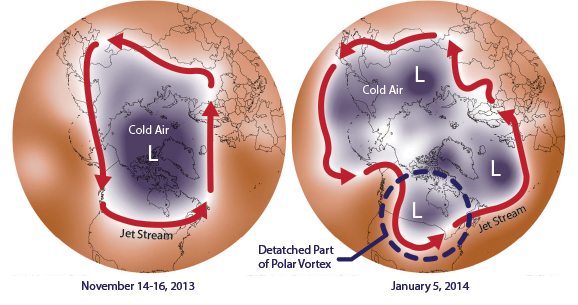Polar Vortex 2016: NASA Infrared Pictures Of Cold Snap Descending On Midwest, Northeast

The polar vortex, which has descended south from the Arctic, has already led to sharp drops on thermometers and icy chills this week. Things weren’t likely to warm up over the next few days in the Midwest and Northeast, either. To help people make heads or tails of what exactly was happening and why their thermostats were hitting such depressing lows, NASA released Tuesday infrared images of the weather moving south and east.
The images showed cold Arctic air arriving in several states — Colorado, Missouri and Kansas — last week. That rush of cold air, which was measured at about 18,000 feet above sea level, was followed by another cold front moving south that was expected to drop temperatures in Ohio and the Northeast.
Weather reports Wednesday warned that the second wave of cold air could be deadly and more disturbing than that initial arrival of the polar vortex. Blizzard winds were possible in some areas. The Weather Channel predicted that some areas could see some of the lowest December temperatures recorded in history. While northern states were expected to be hit by the brunt of the polar vortex, cities in states like Texas were expected to see a wild swing from balmy weather to near-freezing temperatures.
The polar vortex always exists but has become a bit better known lately because it has started to slip south on occasion. It is composed of jet streams circling around the pole (there is one at the South Pole, as well). Sometimes they slip up. When they do, the cold air can rush south to the U.S., Europe or Asia. Eventually the jet streams realign with the pole.
Scientists dispute whether the events will become more likely, but some studies have suggested it's possible because of melting sea ice up north. Regardless, a cold snap here or there may tempt some to say that the weather disproves climate change. But global temperatures are definitely warning — individual weather events notwithstanding — and have been posting record highs.
© Copyright IBTimes 2024. All rights reserved.






















